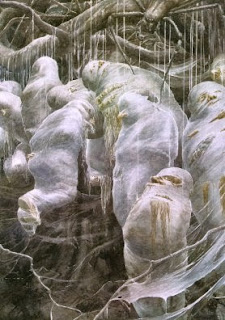It is far from clear why these Italian researchers were seized with a whimsy -- or with a caprice, which is the same thing but in Italian -- to spray spiders with aqueous suspensions of graphene or carbon nanoducts. My own suspicion is that they were entering the arachnids in a gladiatorial tournament and thought to give them an unfair advantage over the spiders from other laboratories, by coating their exoskeletons with nanocarbon armourplate. Not that vile entertainments of this form ever occur at the Old Entomologist, on account of old fever-wracked Mauricio Santos-Lobos always winning.
Clik here to view. So the spiders managed to absorb the nanoplumbing somehow and secrete it as a component of their silk output, reinforcing the threads so they became comparable in strength to the gray, rope-thick reticulations of strands that bridge the bottomless chasm beneath Mount Vormithadreth, that are woven by the spider-god Atlach-Nacha.
So the spiders managed to absorb the nanoplumbing somehow and secrete it as a component of their silk output, reinforcing the threads so they became comparable in strength to the gray, rope-thick reticulations of strands that bridge the bottomless chasm beneath Mount Vormithadreth, that are woven by the spider-god Atlach-Nacha.
This biotech breakthrough might conjure up mental images of giant genegineered spiders in Earth orbit, extruding the threads of a Space Elevator orSkyhook .
Clik here to view. Image may be NSFW.
Image may be NSFW.
Clik here to view.
Left: Space Elevator --
Athanasius Kircher design
This is unlikely to happen soon, however, partly because of the difficulty with designing vacuum apparel for giant spiders, but mainly because the concept is already locked up by a broadly-written patent on 'traversers' whose titanic webs link the Earth to the Trojan-point-locked Moon [Aldiss, 1962] and are capable of snagging starships.
Image may be NSFW.
Clik here to view. Image may be NSFW.
Image may be NSFW.
Clik here to view.
Nevertheless, the Italian results raise some interesting possibilities, and here at Riddled Research Laboratories we are already spraying spiders with Teflon in the hope of fulfilling the age-old dream of creating non-stick webs.
Pugno and his colleagues captured five spiders from the Pholcidae family and sprayed them with a mixture of water and graphene particles 200 to 300 nanometres wide. They also sprayed another 10 spiders with carbon nanotubes and water to compare the effects of the two materials.
Spiders provide dwarves with Kevlar
jackets, where is the gratitude?
Image may be NSFW.jackets, where is the gratitude?
Clik here to view.
 So the spiders managed to absorb the nanoplumbing somehow and secrete it as a component of their silk output, reinforcing the threads so they became comparable in strength to the gray, rope-thick reticulations of strands that bridge the bottomless chasm beneath Mount Vormithadreth, that are woven by the spider-god Atlach-Nacha.
So the spiders managed to absorb the nanoplumbing somehow and secrete it as a component of their silk output, reinforcing the threads so they became comparable in strength to the gray, rope-thick reticulations of strands that bridge the bottomless chasm beneath Mount Vormithadreth, that are woven by the spider-god Atlach-Nacha. Some spiders produced below-par silk, but others got a major boost. The best fibres came from a spider dosed with nanotubes: it was around 3.5 times as tough and strong as the best unaltered silk, spun by the giant riverine orb spider.Bad luck, giant riverine orb spider Caerostris darwini!
This biotech breakthrough might conjure up mental images of giant genegineered spiders in Earth orbit, extruding the threads of a Space Elevator orSkyhook .
Right: Wrong Skyhook
Image may be NSFW.Clik here to view.
 Image may be NSFW.
Image may be NSFW.Clik here to view.

Left: Space Elevator --
Athanasius Kircher design
This is unlikely to happen soon, however, partly because of the difficulty with designing vacuum apparel for giant spiders, but mainly because the concept is already locked up by a broadly-written patent on 'traversers' whose titanic webs link the Earth to the Trojan-point-locked Moon [Aldiss, 1962] and are capable of snagging starships.
Image may be NSFW.
Clik here to view.
.jpg/220px-Hothouse(Aldiss).jpg) Image may be NSFW.
Image may be NSFW.Clik here to view.

Nevertheless, the Italian results raise some interesting possibilities, and here at Riddled Research Laboratories we are already spraying spiders with Teflon in the hope of fulfilling the age-old dream of creating non-stick webs.

